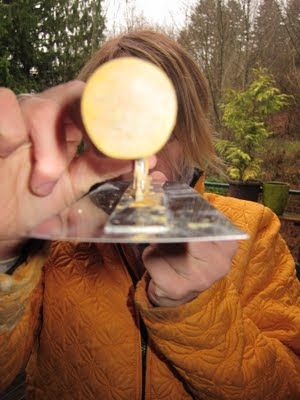4 years of Bellevue College Interior Design school complete! CAD drawings and renderings all rolled up and asleep. My Kodiak M2 and a month's worth of goods & groceries, packed and ready to blow'n'go!
Sitting was my least favorite part of school and I was about to get exactly what I'd been preparing so hard for.
Truck was stuffed and the engine roared, headed on a barge to the San Juans.
Assignment: Complete 8,000 sqft of beautifully crafted clay finishes in a glorious cabin on a sparkling lake nestled on a private island luminating in the Puget Sound. Too good to be true. I could write a book or two on all I've learned through my work, but for now, I'll share this blog.
Method: Work-out alot to build endurance and invest in power tools!!! And eat anything you want for breakfast because you'll burn it off by 10am. A cup of coffee ignites the motors, a beer after work lifts the spirits and stores the next day's carbohydrates. Pack muscle rub!
I started my business in 2005 and have done decent sized projects..a few rooms at a time, fireplaces galore, and fancy powder rooms. This was the first time I was doing a WHOLE house..no paint anywhere..only plaster! Only by the hands of me and my "Assistant Sista" Shannon.
Enter the Kodiak M2.
I bought this portable hopper to allow efficient application of basecoats and ceilings. Victory was declared when in one day we covered close to 2,000 sqft! The machine is connected to a 90 PSI 13 CFM wheelbarrow air compressor. What a sense of power you have when using that machine!
Until it clogs. Then. Work. Slowly. Comes to a. Halt.
Even after I would routinely flush the machine out and perform all proper steps, something would clog..usually the gun tip due to all the joins and grooves. As disempowering as it gets.
I was filthy and fiercely determined.
The machine would eventually come around but alot of time was certainly spent setting up, configuring, and troubleshooting. You realize your tools are the two hands attached to you...so get to work! I've had my bouts of confidence with "Betsy the Beast". From the heights of scaffolding, poised and powerful. To maliciously striking, attaching, and attacking.
As the basecoat phase winded down, artistry revealed itself. Every day and moment it seemed was spent capturing and experiencing nature. The real magic happened when there was no rumbling of the machine, no more gasoline, only the hand and the heart. I don't regret the machine..it allowed me to scale and produce. Above all, I learned when to turn off the machine and tune in to the craft.
Below are some of my experiences with different application tools & techniques. Enjoy!!!
Kodiak M2 Portable Hopper
The machine is easy to clog, especially the gun tip and stator tube. I had the most problems with American Clay's Marittimo since the heavier aggregates tend to sink to the bottom. I used Loma in with the Marittimo to help suspend the aggregates which helped the flow. The Porcelina blows on like a breeze since it's a finer plaster.
Prime it real well with warm soapy water, flush , then slowly coach it into flowing the plaster...crank the hopper speed up to 100! It takes at least two people to operate..one sprays, one backtrowels.
Its an expensive investment (over $4K for machines)..although if you are doing a large area and are on a construction project schedule..its the sure fire way to stay on track without having to subcontract away your costs. Great for basecoats but it can end up looking like knockdown drywall on the topcoats...too flat and not enough hand!!! More prepwork / masking needs to be done due to overspray. Add 10% additional material for overspray / waste.

Hopper with 90 PSI 13 CFM
Works well with viscous, fluid materials (no heavy plasters) Applying sanded primer is a breeze. Less overspray than Kodiak.
Roll-on Application
American Clay released a binder called "Up & Ez" which allows you to roll on the plaster! It works great for ceilings and hard to reach areas..less trips up & down the ladder! Its a good idea if you are just starting to learn. Regardless of how you apply it, you still need to use a binder in the clay, but if you are quick with a trowel you might be better off not rolling it on walls and easy to reach areas. Artistically, you can have a great time rolling on different shades for tonal effects.
Trowel-On
This is the easiest, simplest way to apply plaster. Pointed trowels work best for edges and corners, Pool trowels simplify large scale application. So many different ones! Ceilings are more difficult than walls since the material falls. This is when you might opt to do the "Roll-On" or "Spray-On" application.
Links










You're having so much fun! I love it. Thanks for revealing the plaster world through your beautiful, artistic eyes...
ReplyDeleteThanks a million Carrie!!
ReplyDelete